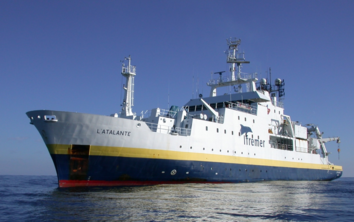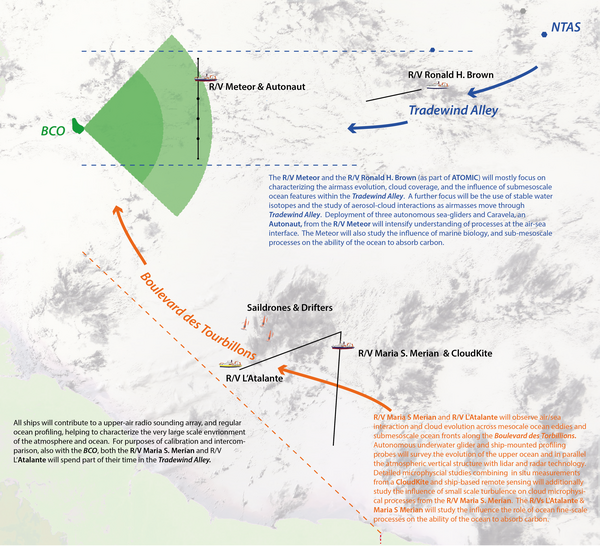EUREC4A-OA


The atmosphere and ocean drive processes in one another through air-sea interaction mechanisms-primarily mixing in turbulent boundary layers. In the trade wind regions, shallow convection and mesoscale circulations in which they are embedded supplement convective mixing in the atmospheric boundary layer. Both shallow convection and its mesoscale signature are thought to influence and be influenced by their interaction with the ocean.
The interaction between shallow convection and the ocean’s surface layers is a two-way street: though shallow convection influences SSTs, it is itself controlled to a large extent by SST and air-sea fluxes, which are mediated by processes within the ocean. Especially Oceanic Barrier Layers (OBL) and mesoscale ocean eddies are believed to be important for these interactions. OBL are near-surface layers created by low salinity waters and embedded in the ocean mixed layer. OBLs tend to decouple the ocean mixed layer from momentum fluxes but also may drive subsurface warming through facilitating the penetration of short wave radiation to the base of the OBL. In doing so, the OBL can influence weather and climate patterns on a range of scales. Ocean mesoscale eddies strongly affect the ocean surface heat budget and therefore SST. They are ubiquitous in the ocean and there is increasing evidence that dynamical processes associated with mesoscale ocean eddies drive SST anomalies which in turn impact the air-sea exchanges and the overlying atmosphere (wind, clouds, rainfall). Preliminary results from satellite and in-situ data show that in the Tropical Northwest Atlantic, ocean eddies are massive heat reservoirs that capture the fresh waters of the Amazon and Orinoco rivers. These regional hotspots are efficient heat and humidity sources for the atmosphere. However, the exact genesis, properties and fate of the regional mesoscale ocean eddies, as well as their precise influence on Tropical Northwest Atlantic air-sea interactions, surface energy budgets, and atmosphere shallow convection is poorly known.
Better understanding of the coupling of the ocean and atmosphere offers the opportunity to evaluate and improve an emerging generation of coupled models capable of resolving phenomena on scales of a few kilometers. The Atlantic Tradewind Ocean-Atmosphere Mesoscale Interaction Campaign (ATOMIC, US) and the Ocean-Atmosphere component of EUREC4A (EUREC4A-OA, Europe) initiatives will take advantage of the complementary existing international EUREC4A intensive atmospheric field campaigns taking place during 6 weeks in January-February 2020 to address the Northwest Tropical Atlantic Ocean-atmosphere interactions at the mesoscale and their relation to the regional OBL, air-sea interactions and atmospheric shallow-convection.

PIs/Contact:
- Johannes Karstensen — Geomar, Kiel
- Sabrina Speich — ENS, Paris

